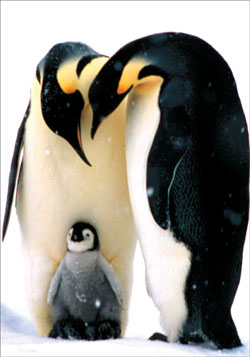Melting sea ice threatens Emperor Penguins
At nearly four feet tall, the Emperor penguin is Antarctica's largest
sea bird -- and thanks to films like "March of the Penguins" and "Happy
Feet," it's also one of the continent's most iconic.
If global temperatures continue to rise, however, the Emperor
penguins inTerre Adélie, in East Antarcticamay eventually disappear,
according to a new study by led by researchers from the Woods Hole
Oceanographic Institution (WHOI).The study was published in the June 20
edition of the journal Global Change Biology.
"Over the last century, we have already observed the disappearance of
the Dion Islets penguin colony, close to the West Antarctic Peninsula,"
says Stephanie Jenouvrier, WHOI biologist and lead author of the new
study. "In 1948 and the 1970s, scientists recorded more than 150
breeding pairs there. By 1999, the population was down to just 20 pairs,
and in 2009, it had vanished entirely." Like in Terre Adélie, Jenouvrier
thinks the decline of those penguins might be connected to a
simultaneous decline in Antarctic sea ice due to warming temperatures in
the region.
Unlike other sea birds, Emperor penguins breed and raise their young
almost exclusively on sea ice. If that ice breaks up and disappears
early in the breeding season, massive breeding failure may occur, says
Jenouvrier.

"As it is, there's a huge mortality rate just at the breeding stages,
because only 50 per cent of chicks survive to the end of the breeding
season, and then only half of those fledglings survive until the next
year," she says.
Disappearing sea ice may also affect the penguins' food source. The
birds feed primarily on fish, squid, and krill, a shrimplike animal,
which in turn feeds on zooplankton and phytoplankton, tiny organisms
that grow on the underside of the ice. If the ice goes, Jenouvrier says,
so too will the plankton, causing a ripple effect through the food web
that may starve the various species that penguins rely on as prey.
To project how penguin populations may fare in the future,
Jenouvrier's team used data from several different sources, including
climate models, sea ice forecasts, and a demographic model that
Jenouvrier created of the Emperor penguin population at Terre Adélie, a
coastal region of Antarctica where French scientists have conducted
penguin observations for more than 50 years.
Combining this type of long-term population data with information on
climate was key to the study, says Hal Caswell, a WHOI senior
mathematical biologist and collaborator on the paper.
"If you want to study the effects of climate on a particular species,
there are three pieces that you have to put together," he says.
"The first is a description of the entire life cycle of the organism,
and how individuals move through that life cycle. The second piece is
how the cycle is affected by climate variables. And the crucial third
piece is a prediction of what those variables may look like in the
future, which involves collaboration with climate scientists."
Marika Holland of the National Center for Atmospheric Research is one
such scientist. She specialises in studying the relationship between sea
ice and global climate, and helped the team identify climate models for
use in the study.
Working with Julienne Stroeve, another sea ice specialist from the
National Snow and Ice Data Center, Holland ultimately recommended five
distinct models. Jenouvrier used the output from these various climate
models to determine how changes in temperature and sea ice might affect
the Emperor penguin population at Terre Adélie. She found that if
greenhouse gas emissions continue to rise at levels similar to today --
causing temperatures to rise and Antarctic sea ice to shrink -- penguin
population numbers will diminish slowly until about 2040, after which
they would decline at a much steeper rate as sea ice coverage drops
below a usable threshold.
"Our best projections show roughly 500 to 600 breeding pairs
remaining by the year 2100. Today, the population size is around 3000
breeding pairs," says Jenouvrier.
- ScienceDaily |

